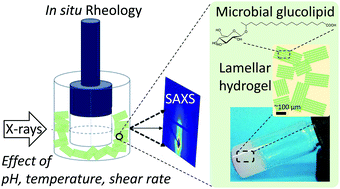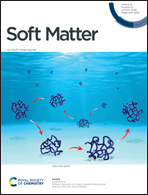Effects of pH, temperature and shear on the structure–property relationship of lamellar hydrogels from microbial glucolipids probed by in situ rheo-SAXS†
Abstract
Lipid lamellar hydrogels are a class of soft materials composed of a defectuous lipid lamellar phase, where defects are classically stabilized by polymer or surfactant inclusions in lipid membranes. We have recently shown that bolaform microbial glucolipids, composed of a single glucose headgroup and a C18:0 fatty acid, with the carboxylic acid group located opposite to glucose, spontaneously form lamellar hydrogels at room temperature below pH 8. In this work, we combine rheology with small angle X-ray scattering (SAXS), rheo-SAXS, to correlate, in situ, the structural and mechanical properties of microbial glycolipid lamellar hydrogels upon application of three different stimuli: pH, temperature and a shear rate. In all cases we find unusual structural features of the lamellar phase if compared to classical phospholipid lamellar structures: reducing pH from alkaline to acidic induces a sol-to-gel transition during which an increasing elastic modulus is associated with an oscillatory evolution of lamellar d(100) spacing; temperature above Tm and increasing shear induce the formation of spherulitic crumpled domains, instead of a classically-expected lamellar-to-vesicle or lamellar-to-onion phase transitions.



 Please wait while we load your content...
Please wait while we load your content...